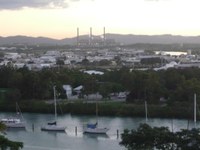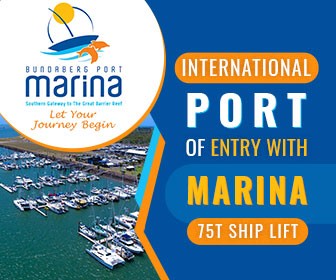Reflections on Antipodean Cruising
The Bright family (UK) on their cutter-rigged sloop Yindee Plus have been cruising the world since 2009. This report from July 2014 is about their time spent in NZ and Australia, and how these countries compare to the rest of the South Pacific.
Published 10 years ago, updated 6 years ago


- View over the river outside the marina in Gladstone, Queensland, Australia: © SY Yindee Plus
Expensive
The first thing that comes to mind is how expensive New Zealand and Australia are. Having crossed the Pacific with a full boat of provisions bought in Panama, we had to face bulk buying this time in very different economic environments. It is possible to find bargains and there are cheaper supermarkets, but we’ve spent a lot more on ‘eat-at-home’ food this last year than we would normally do. We’ve also spent a lot more on repairs and travel too. Sure, you can anchor off somewhere in New Zealand or Australia and spend very little but what’s the point of coming halfway around the world unless you see something of the places? For us, that meant a budget trip to South Island in NZ and a visit to Sydney in Australia. None of that comes cheap but if you want to start doing any of the ‘tourist’ attractions then you need seriously deep pockets.
New Zealand has free customs clearance for yachts, but Australia is expensive. The customs and immigration entry fees are absorbed by the government, but biosecurity charges $330 for their compulsory inspection ($660 if you clear at the weekend). Aussie authorities used to have a bad reputation for heavy-handedness, but that seems to be a thing of the past now. We only heard of one boat in the last year that was made to empty their entire contents onto the quay. We suspect this was because the ‘machine’ picked up traces of narcotics in their bilge. The customs guys take swabs from different areas of the boat and their technology tells them if there have been drugs or firearms aboard. Our experience of Aussie clearance in Gladstone, Queensland, was a very positive one; they were thorough, professional and very friendly.
On the other hand, one of the benefits in this region is you get to sail within a maritime ‘safety net’, provided free, and consequently, boat insurance is low. Both NZ and Australia have well sorted out maritime rescue services and good access to information and weather forecasts via VHF.
Best Sailing in the World
This award definitely goes to the Northern Queensland coast. The Great Barrier Reef protects the water from ocean swell and the constant trade winds during the Aussie winter combine to give excellent conditions for passage making. We normally reckon to make 5 knots average when we’re going anywhere but around here we’ve regularly seen 7 – 8 knots on our log. There are tons of beautiful anchorages too and if you want to make miles rather than day sail, then the ship channel is a perfectly safe route. The only downside to all this is that we were too afraid of the Saltwater Crocodiles to go ashore much. One thing to note about the Great Barrier Reef is that you don’t get to see it from sea level; just occasional sandy cays and palm trees or often just water breaking in the distance. If you have the money (we didn’t), a helicopter ride over the top of it from Cairns would be a great way to view it properly.
Fixing the Boat
New Zealand is a fantastic place to do boat repairs. From our limited experience of Aussie boatyards though, the rules and regulations may get in the way of you working on your own boat or even living on the boat on the hard and the repairs we made here were very expensive. Best to get lots of information before you make your choice.
Medical stuff
NZ has some of the most expensive pharmacies and dentists we’ve come across anywhere. Fiji has cheap chemists where you can buy antibiotics over the counter; we used the Trimethoprim that we bought there and it worked fine. So maybe best to try and stock up with meds in the islands.
NZ does have reciprocal healthcare arrangements with some countries, including the UK. We met one couple who had had extensive treatment which was covered by this arrangement, but not everything is. In Australia, we were advised to sign up to Medicare. It was surprisingly easy: just go along to a Medicare Office (look on the internet), take your passports and visas, and you can sign up there and then and be given a temporary Medicare card to use. You need to provide an Aussie address. If you don’t have an Aussie bank account for them to reimburse you into, then just make sure you go to any doctor who ‘bulk bills’ (they normally advertise this). The surgery then makes the claim for you and you don’t have to hand over any money. We saved ourselves about $800 on consultation fees for our triple Rabies vaccines for Indonesia by using Medicare; fantastic.
Australia has some budget pharmacies where you can save quite a bit of money; good for stocking up on bug repellent/sunscreen and toothpaste etc.
Non-functioning Binoculars
The compass on our Fujinon binoculars starting sticking when we were at about 15 degrees south and didn’t work at all by the time we were in NZ. Apparently, they don’t work in the Southern Hemisphere! That would explain why it’s not possible to buy any binoculars with compasses around here. So, if you need to replace your current ones then do so before you arrive in the Antipodes or be prepared to ship them from Europe or the USA. We’ve noticed that the compass has just about started to work again now that we are at 10 degrees south (northern Australia).
Lowrance Chart Plotter HDS 5 gen 2
We fitted this small chart plotter at the binnacle while we were in the USA. It was brilliant….until we crossed the International Date Line. Suddenly an error message flashed up at the bottom of the screen saying “Unit not valid for use in this area: contact an authorized dealer for help”. Yep, in the small print of the instruction manual, it does mention the fact that it is designed for the western hemisphere only! If you’d like to get rid of the error message and persuade the plotter to work as normal follow these instructions: go into simulator mode; move the cursor; exit simulator mode; reload Navionics charts or equivalent; check that depths etc are in the desired measurements (just because it says metres on the home screen don’t assume that this is so); use as usual. No, we didn’t contact the dealer…Chris spent an hour or so figuring it out.
Charts and Cruising Guides
Getting hold of charts and guides for international cruising was surprisingly difficult in NZ which we were very surprised to find and it’s not that easy in Australia either. There are organizations in some of the larger cities like Sydney and Darwin who sell this stuff and will ship it to wherever you are, but you certainly can’t walk into any old chandlery and buy it. Books, in general, tend to be very expensive down under and even second-hand ones aren’t cheap. If you come across second-hand charts or guides for this area, or for SE Asia, before you leave the Caribbean, then snap them up.
Navtex
There is no Navtex coverage in the South Pacific, NZ or Australia. The last time we had access to it was US coverage of the Gulf of Mexico. Indonesia allegedly has it but we haven’t read any reports of anyone who’s picked it up there.
Susan Bright
SY Yindee Plus
http://www.yindeeplus.net/Yindee_Plus/Welcome.html
The Bright family on their cutter-rigged sloop Yindee Plus are in Indonesia at the time of posting, having begun their extended cruising from the UK in 2008. Their blog has lots of interesting reports and twin sons Sid and Wilf have their own blogs also.
Related content
Related to following destinations: Australia, New Zealand








Posted on behalf of SY Yindee Plus:
No, we didn’t take out the Navionics card before switching to the simulator. After we checked the simulator box, we exited that menu to go back to the main screen (which should now be in the simulator rather than Navionics). Then we moved the cursor a little. Then go back to the menu and de-select simulator, then check re-load Navionics.
One important thing since we found all this out in the Pacific is that the new software updates for the plotter have removed this ‘loophole’ for getting rid of the error message. After we loaded the update and realized this, Chris took a couple of hours to unload the software and get it back to the point where we could do the simulator trick. So, unfortunately, you may have a machine with new software on it and simply can’t get rid of that very annoying message.
Our Lowrance broke recently. We didn’t like spending the money on a replacement but because we had it shipped from the UK it’ll work anywhere in the world and we don’t have to mess about with the message. We assume the U.S. Version issue must be a copyright thing.
Posted on behalf of Bruce and Laura Masterson:
We bought our Lowrance in San Diego and, like you, got the annoying flashing message when we crossed the dateline. I tried following your instructions but to no avail.
Questions:
1. Did you take out your navionics card before or after going into Simulator? I only take out the card when the Lowrance is turned off, so do I do this before powering up or turn the unit off and removing the card after Simulator?
2. After I go to Simulator and check the box, do I need to do anything else? The next line has the options, off, Saltwater, and Standard. If I pick one of these, then I get a screen where I can move the cursor as you said in your instructions. Then, do I uncheck the Simulator Box? turn the unit off, and re-insert the card? This is what I tried, and I still have the flashing message.